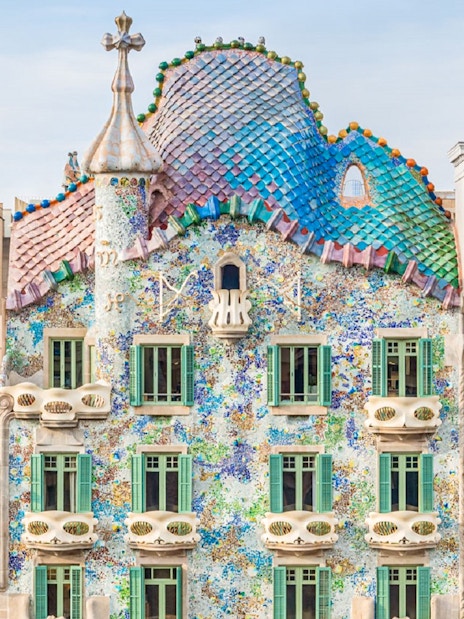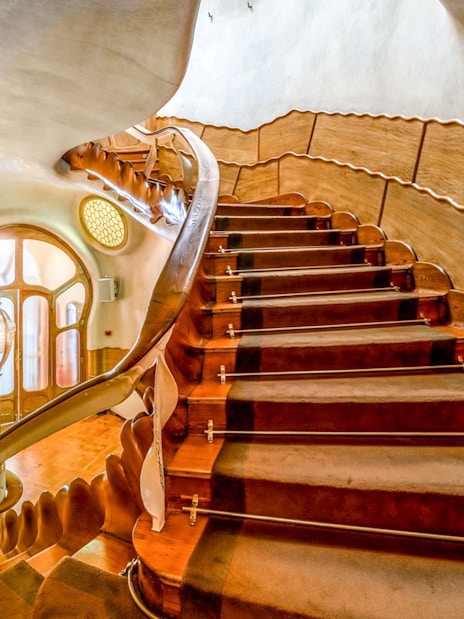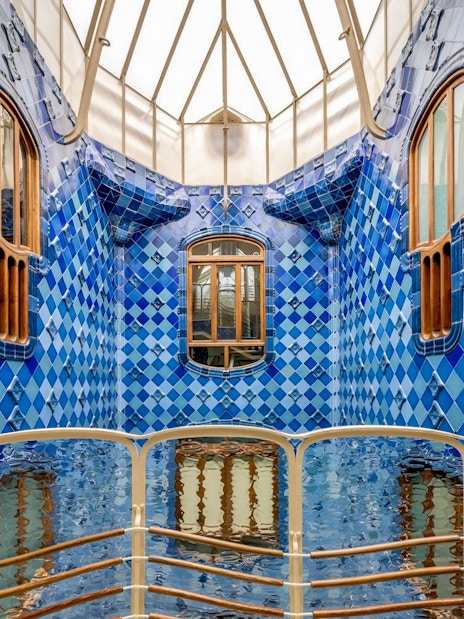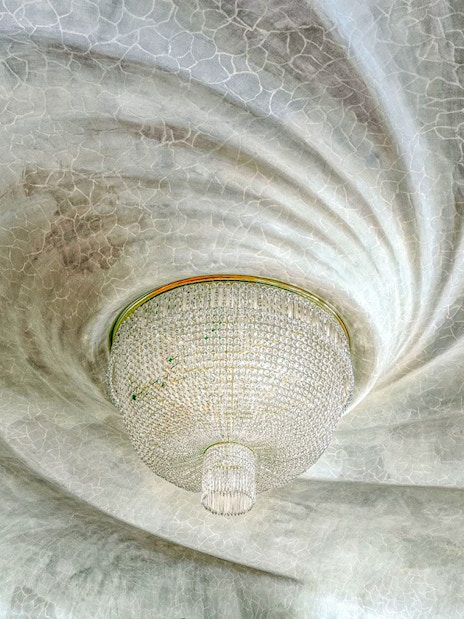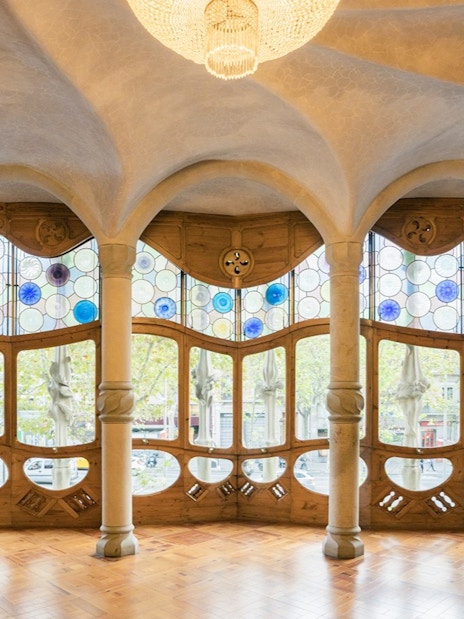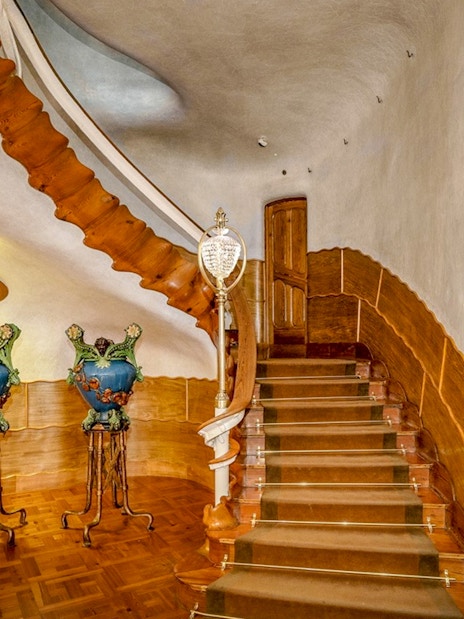- Sagrada Familia Tickets
- Park Güell
- Barcelona Flamenco Show Kaartjes
- Camp Nou tours
- Casa Mila Tickets
- De wereld van Banksy Barcelona
- Portaventura Wereld
- Hola Barcelona Travel Card
- Wassenbeeldenmuseum Barcelona
- Tickets voor Palau de la Música Catalana
- Erotisch Museum van Barcelona
- Klooster Montserrat
- Dierentuin van Barcelona
- Groot Plezier Museum
- Aquarium van Barcelona
Boek Casa Batllo tickets
Wij zijn een betrouwbare partner die een selectie van de beste tickets en tours aanbiedt. Dit is niet de officiële website.

- Waarom omzeil je de rij niet en ga je Fast-Track naar Casa Batlló? Verken Gaudí's meesterwerk, gebouwd door inspiratie uit de natuur te halen.
- Een Engelssprekende gids geeft live inzicht in het werk van Gaudí via een in-ear radio systeem terwijl je er doorheen loopt.
- Zie hoe de gevel van het gebouw lijkt op het oppervlak van een rustig meer, met golvende lijnen en een levendig kleurenpalet dat de tinten nabootst die je in het zeeleven aantreft.
- Klim naar het dak van Casa Batlló, dat vaak wordt vergeleken met de rug van een draak, met kleurrijke mozaïektegels die zijn schubben voorstellen en een prominente gebogen ruggengraat.
- Verschillende kenmerken van Casa Batlló zouden een symbolische betekenis hebben, waaronder de balkons, die de schedels van de slachtoffers van de draak zouden symboliseren.
- Waarom omzeil je de rij niet en ga je Fast-Track naar Casa Batlló? Verken Gaudí's meesterwerk, gebouwd door inspiratie uit de natuur te halen.
- Een Engelssprekende gids geeft live inzicht in het werk van Gaudí via een in-ear radio systeem terwijl je er doorheen loopt.
- Zie hoe de gevel van het gebouw lijkt op het oppervlak van een rustig meer, met golvende lijnen en een levendig kleurenpalet dat de tinten nabootst die je in het zeeleven aantreft.
- Klim naar het dak van Casa Batlló, dat vaak wordt vergeleken met de rug van een draak, met kleurrijke mozaïektegels die zijn schubben voorstellen en een prominente gebogen ruggengraat.
- Verschillende kenmerken van Casa Batlló zouden een symbolische betekenis hebben, waaronder de balkons, die de schedels van de slachtoffers van de draak zouden symboliseren.
Inclusief
- Versnelde toegang tot Casa Batllo
- Deskundige Engelssprekende gids
- Toegang tot de Kubus van Gaudí
- Gids
- Tip: Bezoek de Attic, waar een tentoonstelling over het leven en werk van Antoni Gaudí te zien is.
- Shutterbugs, let op: flitsfotografie en statieven zijn verboden in de zaal.
- Je annuleert deze tickets tot 24 uur voor de belevenis begint en krijgt een volledige terugbetaling.
Combo's
Combo: Park Güell Tickets met audiogids + Casa Batlló Skip-the-Line Tickets
vanaf
€ 61
Bezoek twee mozaïekwonderen en ontdek Gaudí's uitzonderlijke kleurgebruik!
- Pak dit kaartje om Gaudí's gedurfde, eigenzinnige woningontwerpen te zien en stel je een leven voor waarin jij ze thuis kunt noemen!
- Gedraaide stenen zuilen die takken nabootsen en kronkelende wandelpaden die lijken te zweven - elke centimeter van Park Güell weerspiegelt Gaudí's innovatieve geest.
- Stem af op een meertalige audiogids voor een beter begrip van Gaudí's visie en een beweging die de skyline van Barcelona voor altijd veranderde.
- Dump de rijen bij Casa Batlló en stap in een zeefantasie! Vergaap je aan het iriserende dak met drakenschubben, de skeletachtige balkons en de golvende plafonds.
- Geniet van de schoonheid van Gaudí's Koepel, Batlló's privékamer, buitenlounge en paddenstoelvormige open haard; inspiratie voor je droomhuis wacht op je!!!
Bezoek twee mozaïekwonderen en ontdek Gaudí's uitzonderlijke kleurgebruik!
- Pak dit kaartje om Gaudí's gedurfde, eigenzinnige woningontwerpen te zien en stel je een leven voor waarin jij ze thuis kunt noemen!
- Gedraaide stenen zuilen die takken nabootsen en kronkelende wandelpaden die lijken te zweven - elke centimeter van Park Güell weerspiegelt Gaudí's innovatieve geest.
- Stem af op een meertalige audiogids voor een beter begrip van Gaudí's visie en een beweging die de skyline van Barcelona voor altijd veranderde.
- Dump de rijen bij Casa Batlló en stap in een zeefantasie! Vergaap je aan het iriserende dak met drakenschubben, de skeletachtige balkons en de golvende plafonds.
- Geniet van de schoonheid van Gaudí's Koepel, Batlló's privékamer, buitenlounge en paddenstoelvormige open haard; inspiratie voor je droomhuis wacht op je!!!
Inclusief
Park Güell
- Toegang tot Park Güell
- Audiogids in het Spaans, Engels, Duits, Italiaans en Frans
Casa Batlló
- Toegang met voorrang tot Casa Batlló
- Audiogids in 15 talen bij de ingang
Park Güell
- Tip: Het is geen verrassing dat er in Park Guell van alles te zien is. Zorg er dus voor dat je je bezoek zo plant dat je genoeg tijd hebt om het park te verkennen.
- Voor bezoekers met mobiliteitsproblemen biedt Park Güell gratis twee rolstoelen te huur aan (afhankelijk van beschikbaarheid).
- De parkeerplaats voor touringcars beschikt over drie plaatsen voor personen met beperkte mobiliteit.
Casa Batlló
- Tip: Ga weg van de drukte door de trap naar boven te nemen en wat tijd alleen door te brengen op het dakterras van het gebouw, poserend met de iconische schoorstenen.
- Faciliteiten: Toegankelijk voor rolstoelen.
- Deze tickets kunnen niet geannuleerd of verschoven worden.
Combo's
Tickets voor 2 huizen van Gaudí: Casa Milà en Casa Batlló
vanaf
€ 64
Oproep aan alle architectuurliefhebbers voor een diepe duik in 2 unieke woonruimtes ontworpen door Gaudí!
- Verken Gaudí's unieke benadering van architectuur op de Unesco-locaties La Pedrera-Casa Milà en Casa Batlló, met slechts één handige combo.
- Baan je een weg door de lijnen en verken Gaudí's modernistische wonder Casa Milà. Een audiogids onthult hoe de zee zijn verbluffende ontwerp inspireerde.
- Bezoek Casa Batlló en duik in het brein van Gaudí. De 360º Cube en een meertalig audiocommentaar brengen zijn visie en verhaal tot leven.
- Wil je nog meer? Met de optie zilver krijg je toegang tot het drakendak van Casa Batlló en met goud krijg je een exclusievere toegang, inclusief het privéverblijf!
Oproep aan alle architectuurliefhebbers voor een diepe duik in 2 unieke woonruimtes ontworpen door Gaudí!
- Verken Gaudí's unieke benadering van architectuur op de Unesco-locaties La Pedrera-Casa Milà en Casa Batlló, met slechts één handige combo.
- Baan je een weg door de lijnen en verken Gaudí's modernistische wonder Casa Milà. Een audiogids onthult hoe de zee zijn verbluffende ontwerp inspireerde.
- Bezoek Casa Batlló en duik in het brein van Gaudí. De 360º Cube en een meertalig audiocommentaar brengen zijn visie en verhaal tot leven.
- Wil je nog meer? Met de optie zilver krijg je toegang tot het drakendak van Casa Batlló en met goud krijg je een exclusievere toegang, inclusief het privéverblijf!
Inclusief
La Pedrera-Casa Milà
- Versnelde toegang tot La Pedrera-Casa Milà
- Audiogids in het Catalaans, Spaans, Engels, Frans, Duits, Portugees, Italiaans, Russisch, Japans en Koreaans
Casa Batlló
- Tijdsgebonden toegang tot Casa Batlló (volgens geselecteerde optie)
- Audiogids in het Spaans, Catalaans, Engels, Frans, Italiaans, Portugees, Duits, Nederlands, Pools, Roemeens, Russisch, Koreaans, Mandarijn Chinees, Kantonees Chinees en Japans
- Toegang tot Gaudí Cube
- Toegang tot Gaudí Dome (volgens geselecteerde optie)
- Augmented Reality Tablet (volgens geselecteerde optie)
- Conciërge (volgens geselecteerde optie)
- Toegang tot het privéverblijf van de familie Batlló (volgens de gekozen optie)
- Toegang tot Drakendak (volgens geselecteerde optie)
La Pedrera-Casa Milà
- Tip: bezoek dit architectonische hoogstandje bij zonsondergang om een prachtig uitzicht vanaf het dak vast te leggen.
- Faciliteiten: toegankelijk voor rolstoelen, toegankelijk voor kinderwagens, toegankelijke toiletten.
- Geleidehonden zijn toegestaan.
Casa Batlló
- Tip: als je een liefhebber bent van vintage decor, mag je het appartement op de 4e verdieping vol meubilair uit de 20e eeuw niet missen.
- Deze tickets kunnen niet geannuleerd of verschoven worden.
- Ervaar het beste van Barcelona, sla de wachtrijen over bij meer dan 25 attracties en reis gemakkelijk met het openbaar vervoer, allemaal met één eenvoudige stadspas.
- Bezoek Casa Batllò, geniet van tapas, wandel in het Montserrat Natuurpark of maak een catamarantocht bij zonsondergang - en bespaar maar liefst 60% op tickets alleen!
- Kies de geldigheidsduur van je pas van 1 tot 7 dagen, afhankelijk van of je de voorkeur geeft aan een snelle sweep of een ontspannen verkenning van Barcelona.
- Rijd door de stad zonder je in het zweet te werken of de bank te spekken. Geniet van toegang tot bussen, metro's, treinen en trams plus een 24-uurs hop-on hop-off tour.
- Scan je digitale pas en maak je klaar om in een mum van tijd bezienswaardigheden te verkennen. De pas zit ook boordevol leuke kortingen!
- Ervaar het beste van Barcelona, sla de wachtrijen over bij meer dan 25 attracties en reis gemakkelijk met het openbaar vervoer, allemaal met één eenvoudige stadspas.
- Bezoek Casa Batllò, geniet van tapas, wandel in het Montserrat Natuurpark of maak een catamarantocht bij zonsondergang - en bespaar maar liefst 60% op tickets alleen!
- Kies de geldigheidsduur van je pas van 1 tot 7 dagen, afhankelijk van of je de voorkeur geeft aan een snelle sweep of een ontspannen verkenning van Barcelona.
- Rijd door de stad zonder je in het zweet te werken of de bank te spekken. Geniet van toegang tot bussen, metro's, treinen en trams plus een 24-uurs hop-on hop-off tour.
- Scan je digitale pas en maak je klaar om in een mum van tijd bezienswaardigheden te verkennen. De pas zit ook boordevol leuke kortingen!
Inclusief
- Geldigheid: 1, 2, 3, 4, 5, 6 of 7 dagen
- Onbeperkt openbaar vervoer voor 1/2/3/4/5 dagen
- 24 uur hop-on hop-off bustour
- Musea: F.C. Barcelona Museum, Magic World Fun Museum, Moco Museum en meer
- Bezienswaardigheden: Casa Milà - La Pedrera, Casa Batlló, Casa Amatller en meer
- Cruises: originele havencruises, catamarantour bij zonsondergang en meer
- Rondleidingen: oude stad door de Gotische wijk (Engels- of Duitssprekende gids), tapas-wandeltour, wandeltour met Picasso Museum en meer
- Activiteiten: ontdek de magie van Poble Espanyol,(een Spaans dorp in het hart van Barcelona), Telefèric de Montjuïc, paella-kookles en meer
- Kortingen bij Barcelona Ciclotour, Casa Amatller en meer
- Alle details hier
Niet inbegrepen
- Nachtbussen
- De meeste musea in Barcelona zijn op maandag en mogelijk op feestdagen gesloten.
- Sommige attracties, musea en bezienswaardigheden zijn soms niet beschikbaar vanwege renovaties.
- De Barcelona City Pass is verkrijgbaar in het Duits, Engels en Frans. Na het afronden van je boeking krijg je de pas per e-mail toegestuurd met alle essentiële informatie over openingstijden, adressen en toegangskaartjes.
- De toegang tot de hop-on hop-off-bus is slechts 1 dag beschikbaar, ongeacht de geldigheidsoptie die je kiest voor de stadspas.
- Je kunt elke inbegrepen en afgeprijsde attractie maar één keer bezoeken.
- Voor sommige attracties moet je reserveren. Je pas moet geldig zijn op de dag van de reservering.
- De geldigheid van de pas begint op de datum die je kiest bij het plaatsen van je bestelling.
- Ga papierloos werken! Vergeet het uitprinten van kaartjes, laat gewoon je digitale pas zien bij binnenkomst.
- Nadat je de aankoop hebt gedaan, ontvang je een e-mail van Barcelona Turbopass met de link naar je digitale pas en een boekingsapp.
- Klik op de link en activeer je pas. Selecteer de datum waarop je het wilt gaan gebruiken.
- Blader door de boekingsapp om te zien voor welke attracties je moet reserveren en boek je slots met een paar eenvoudige klikken. Volg gewoon de eenvoudige instructies en voila! Je kunt aan de slag.
- Je pas wordt automatisch geactiveerd op de datum die je tijdens het bestellen hebt geselecteerd.
- De pas biedt ook gratis toegang tot treinen, metro's, trams en bussen vanaf het vliegveld en binnen de stad voor 2, 3, 4 of 5 dagen, afhankelijk van je pas. Je vervoersbewijs wordt alleen geactiveerd bij het eerste gebruik van het openbaar vervoer.
Geldigheid
- Na activering: Je pas wordt geactiveerd op de datum die je hebt gekozen tijdens het afrekenen en is geldig voor het aantal opeenvolgende kalenderdagen (geen periodes van 24 uur) dat je hebt gekozen. Als je bijvoorbeeld een 3-daagse pas kiest en op maandagmiddag een attractie bezoekt, is je pas geldig voor de rest van de maandag plus de daaropvolgende dinsdag en woensdag.
- Je annuleert deze tickets tot 24 uur voor de belevenis begint en krijgt een volledige terugbetaling.

